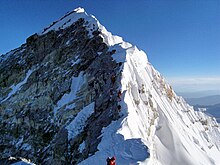
In mountaineering, the death zone refers to altitudes above which the pressure of oxygen is insufficient to sustain human life for an extended time span. This point is generally agreed as 8,000 m (26,000 ft), where atmospheric pressure is less than 356 millibars (10.5 inHg; 5.16 psi).[1] The concept was conceived in 1953 by Edouard Wyss-Dunant, a Swiss doctor, who called it the lethal zone.[2] All 14 peaks above 8000 m (the "eight-thousanders") in the death zone are located in the Himalaya and Karakoram regions of Asia.
Many deaths in high-altitude mountaineering have been caused by the effects of the death zone, either directly by the loss of vital functions or indirectly by poor decisions made under stress (e.g., not turning back in deteriorating conditions, or misreading the climbing route), or physical weakening leading to accidents (e.g., falls). An extended stay above 8,000 m (26,000 ft) without supplementary oxygen will result in deterioration of bodily functions and death.[3][4][5]
- ^ "Everest: The Death Zone". Nova. PBS. 1998-02-24.
- ^ Wyss-Dunant, Edouard (1953). "Acclimatisation" (PDF). The Mountain World: 110–117. Retrieved March 10, 2013.
- ^ Darack, Ed (2002). Wild winds: adventures in the highest Andes. Ed Darack. p. 153. ISBN 978-1-884980-81-7.[permanent dead link]
- ^ Huey, Raymond B.; Eguskitza, Xavier (2 July 2001). "Limits to human performance: elevated risks on high mountains". Journal of Experimental Biology. 204 (18): 3115–9. doi:10.1242/jeb.204.18.3115. PMID 11581324.
- ^ Grocott, Michael P.W.; Martin, Daniel S.; Levett, Denny Z.H.; McMorrow, Roger; Windsor, Jeremy; Montgomery, Hugh E. (2009). "Arterial Blood Gases and Oxygen Content in Climbers on Mount Everest" (PDF). N Engl J Med. 360 (2): 140–9. doi:10.1056/NEJMoa0801581. PMID 19129527.